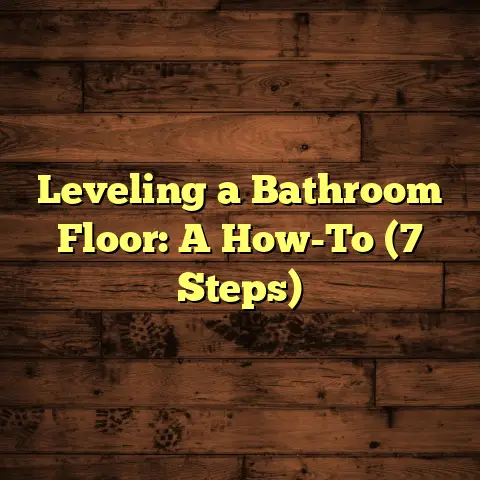Murphy’s Soap on Hardwood? (2 Signs of Film!)
And let me tell you, I’ve seen it all when it comes to hardwood floors.
From pet stains to water damage, and yes, even the dreaded film buildup from cleaning products.
In today’s world, we’re bombarded with the latest and greatest in cleaning technology.
I mean, we’ve got robotic vacuums that practically live under our couches, and spray mops that promise sparkling floors with minimal effort.
Plus, the rise of eco-friendly cleaning solutions has been a game-changer, with more and more homeowners seeking products that are both effective and safe for their families and the environment.
But amidst all these innovations, there’s one old-school cleaner that still pops up in conversations: Murphy’s Oil Soap.
It’s been around for ages, and many swear by it for cleaning their hardwood floors.
But is it really the best choice?
Can it actually cause problems like a noticeable film?
That’s what we’re diving into today.
We’ll explore the ins and outs of Murphy’s Soap, how it interacts with hardwood, and most importantly, how to spot and deal with that pesky film.
So, grab a cup of coffee, settle in, and let’s get started!
Section 1: Understanding Murphy’s Soap
A Bit of History
Murphy’s Oil Soap has been a household name for over a century.
It was first created way back in the early 1900s, and quickly gained popularity for its ability to clean wood without harsh chemicals.
Its origins are rooted in the need for a gentle yet effective cleaner that could preserve the natural beauty of wood furniture and floors.
Over the years, it became a staple in homes across America, passed down through generations as a trusted cleaning solution.
What’s in the Bottle?
The magic of Murphy’s Oil Soap lies in its composition.
It’s primarily made from natural ingredients, including vegetable oils like soybean and linseed oil, water, and soap.
These ingredients work together to create a cleaning solution that’s designed to penetrate and dissolve dirt and grime without stripping the wood’s natural oils.
The soap component helps to lift away dirt, while the oils help to moisturize and protect the wood.
The Good Stuff
One of the main reasons why Murphy’s Oil Soap has remained popular is its reputation for being gentle yet effective.
It’s often praised for its ability to clean hardwood floors without leaving behind a sticky residue.
Many homeowners appreciate that it’s a relatively mild cleaner, which makes it suitable for use on a variety of wood surfaces.
Plus, the natural oils in the soap can help to enhance the wood’s natural shine and luster.
What People Say
Consumer perceptions of Murphy’s Oil Soap are generally positive.
Many users rave about its ability to clean their hardwood floors without damaging the finish.
I’ve heard countless stories from clients who’ve used it for years and swear it’s the best thing for their floors.
However, I’ve also encountered homeowners who’ve had less favorable experiences, citing issues like film buildup or dullness over time.
It really seems to depend on a variety of factors, including the type of hardwood, the finish, and how the product is used.
Section 2: The Science Behind Hardwood Flooring
Wood Types
Hardwood flooring comes in all shapes and sizes, literally!
You’ve got your classic oak, which is known for its durability and versatility.
Then there’s maple, which is a bit harder and has a smoother grain.
And don’t forget about cherry, walnut, and hickory, each with its own unique color and character.
Engineered hardwood is also a popular choice, consisting of a thin layer of real hardwood bonded to a plywood core.
Each type of hardwood has its own unique properties, which can affect how it responds to cleaning products.
Why Maintenance Matters
Proper maintenance is crucial for keeping your hardwood floors looking their best.
Regular cleaning helps to remove dirt, dust, and grime that can scratch and damage the finish over time.
It also helps to prevent the buildup of stubborn stains and discoloration.
By taking good care of your hardwood floors, you can extend their lifespan and maintain their beauty for years to come.
The Dark Side of Cleaning Products
Not all cleaning products are created equal, and some can actually do more harm than good to your hardwood floors.
Harsh chemicals, abrasive cleaners, and even excessive water can damage the finish, leading to scratches, discoloration, and other problems.
One of the biggest risks is the formation of residue or film on the surface of the floor.
This film can dull the shine, attract dirt, and even make the floor slippery.
The Dreaded Film
Film buildup on hardwood floors is a common issue that I see all too often.
It’s often caused by the improper use of cleaning products, including over- application, inadequate rinsing, or using products that are not specifically designed for hardwood floors.
Murphy’s Oil Soap, while generally considered gentle, can also contribute to film buildup if not used correctly.
The oils in the soap can accumulate over time, creating a sticky or greasy layer on the surface of the floor.
Section 3: Identifying Film on Hardwood Floors
Alright, let’s get down to the nitty-gritty.
How do you actually know if you’ve got film buildup on your hardwood floors?
Here are the two main signs to watch out for:
1. Dull Appearance
One of the most obvious signs of film buildup is a dull, lackluster appearance.
Your hardwood floors should have a natural shine and luster, reflecting light and adding warmth to your home.
But when film accumulates on the surface, it can block the light and make the floors look dull and lifeless.
Instead of a vibrant, glossy finish, you might notice a hazy or cloudy appearance.
It’s like a veil has been cast over your floors, dimming their natural beauty.
Visual Aid:
Imagine two side-by-side photos of the same hardwood floor.
In one photo, the floor is clean and shiny, with light reflecting evenly across the surface.
In the other photo, the floor is dull and hazy, with little to no light reflection.
The difference is striking, and it’s a clear indication of film buildup.
2. Slippery Surface
Another telltale sign of film buildup is a slippery surface.
While you might think that a clean floor should be smooth and easy to walk on, film can actually create a slick, almost greasy feel underfoot.
This is especially dangerous for children, elderly individuals, or anyone with mobility issues.
A slippery floor can increase the risk of falls and injuries, making it a serious safety hazard.
Why does this happen?
The film acts as a lubricant, reducing the friction between your feet and the floor.
It’s like walking on a thin layer of oil, which can cause you to lose your footing and slip.
How to Detect Film
So, how can you be sure that you’re dealing with film buildup and not just normal wear and tear?
Here’s a simple test you can try:
- The Touch Test: Run your hand across the surface of the floor. Does it feel smooth and clean, or does it feel sticky, greasy, or waxy? If it feels anything other than clean, you likely have film buildup.
- The Reflection Test: Get down on your hands and knees and look at the floor from a low angle. Can you see a hazy or cloudy layer on the surface? Does the light reflect unevenly? These are signs of film.
- The Water Test: Sprinkle a few drops of water on the floor. Does the water bead up, or does it spread out evenly? If the water beads up, it’s a sign that there’s a film preventing it from absorbing into the wood.
If you notice any of these signs, it’s time to take action and remove the film from your hardwood floors.
Section 4: Cleaning Techniques to Remove Film
Okay, so you’ve identified film buildup on your hardwood floors.
Don’t panic!
It’s a common problem, and with the right techniques, you can get your floors looking shiny and new again.
Here’s a step-by-step guide to removing film from hardwood floors:
Step 1: Gather Your Supplies
Before you start, gather the following supplies:
- A bucket
- Warm water
- White vinegar (optional)
- A pH-neutral hardwood floor cleaner (check the label!)
- A microfiber mop or cleaning cloth
- A second bucket with clean water for rinsing
Step 2: Prep the Area
Clear the area of any furniture, rugs, or other obstacles.
Sweep or vacuum the floor thoroughly to remove any loose dirt, dust, or debris.
Step 3: Mix Your Cleaning Solution
In your bucket, mix warm water with either a pH-neutral hardwood floor cleaner or a solution of water and white vinegar.
If using a hardwood floor cleaner, follow the manufacturer’s instructions for dilution ratios.
If using white vinegar, mix one part vinegar with ten parts water.
Why vinegar?
White vinegar is a natural cleaner and degreaser that can help to break down film buildup without damaging the finish of your hardwood floors.
However, it’s important to use it sparingly and dilute it properly, as too much vinegar can be acidic and potentially harm the wood.
Step 4: Mop the Floor
Dip your microfiber mop or cleaning cloth into the cleaning solution, making sure to wring out any excess liquid.
You want the mop to be damp, not soaking wet.
Mop the floor in small sections, using a back-and-forth motion.
Pay special attention to areas with visible film buildup, and apply a bit more pressure if needed.
Step 5: Rinse the Floor
After mopping a section of the floor, rinse the mop or cleaning cloth in the second bucket of clean water.
Wring out any excess water and then mop the section again to remove any remaining cleaning solution.
It’s important to rinse the floor thoroughly to prevent any residue from being left behind.
Step 6: Dry the Floor
Once you’ve mopped and rinsed the entire floor, use a clean, dry microfiber cloth to dry the surface.
This will help to prevent water spots and streaks.
Make sure to dry the floor thoroughly, as excess moisture can damage the wood.
Step 7: Repeat if Necessary
If you still notice film buildup after the first cleaning, repeat the process.
You may need to do this several times to completely remove the film, especially if it’s been there for a while.
What About Murphy’s Oil Soap?
You might be wondering, “Can I use Murphy’s Oil Soap to remove film buildup?”
The answer is…it depends.
While Murphy’s Oil Soap is often used to clean hardwood floors, it can also contribute to film buildup if not used correctly.
If you choose to use Murphy’s Oil Soap, make sure to dilute it properly and rinse the floor thoroughly afterward.
I’d recommend using a pH-neutral cleaner or vinegar solution for removing film, as they are less likely to leave behind a residue.
Important Note:
Always test any cleaning solution in an inconspicuous area before applying it to the entire floor.
This will help to ensure that it doesn’t damage the finish or cause any discoloration.
Section 5: Long-term Maintenance of Hardwood Floors
Once you’ve successfully removed the film from your hardwood floors, it’s important to establish a long-term maintenance routine to prevent it from coming back.
Here are some tips to keep your floors looking their best:
Routine Cleaning
- Sweep or vacuum regularly: Aim to sweep or vacuum your hardwood floors at least once a week to remove loose dirt, dust, and debris.
- Mop as needed: Mop your hardwood floors every few weeks, or as needed, to remove spills and stains.
- Use the right products: Always use cleaning products that are specifically designed for hardwood floors.
- Avoid harsh chemicals: Stay away from abrasive cleaners, bleach, and other harsh chemicals that can damage the finish.
Preventing Film Buildup
- Dilute cleaning solutions properly: Always follow the manufacturer’s instructions for diluting cleaning solutions.
- Rinse thoroughly: After mopping, rinse the floor thoroughly with clean water to remove any remaining cleaning solution.
- Dry the floor: Dry the floor immediately after rinsing to prevent water spots and streaks.
- Avoid over-wetting: Use a damp mop, not a soaking wet one, to clean your hardwood floors.
- Use mats and rugs: Place mats and rugs at entrances and high-traffic areas to trap dirt and prevent it from being tracked onto your hardwood floors.
Professional Cleaning and Refinishing
- Consider professional cleaning: Every year or two, consider hiring a professional cleaning service to deep clean your hardwood floors.
- Refinish when needed: Over time, your hardwood floors may start to show signs of wear and tear, such as scratches, dents, and discoloration.
The Dos and Don’ts of Hardwood Floor Maintenance
Do:
- Sweep or vacuum regularly
- Use a pH-neutral hardwood floor cleaner
- Dilute cleaning solutions properly
- Rinse and dry the floor thoroughly
- Use mats and rugs to protect the floor
Don’t:
- Use abrasive cleaners or harsh chemicals
- Over-wet the floor
- Let spills sit for long periods of time
- Wear shoes with high heels or cleats on the floor
- Drag heavy furniture across the floor
Conclusion
So, there you have it!
A comprehensive guide to understanding Murphy’s Oil Soap and its effects on hardwood floors.
We’ve explored the history of Murphy’s Soap, the science behind hardwood flooring, how to identify film buildup, and how to remove it effectively.
We’ve also discussed long-term maintenance tips to keep your hardwood floors looking their best for years to come.
Remember, maintaining hardwood floors is all about striking a balance between effective cleaning and gentle care.
While traditional products like Murphy’s Oil Soap can be useful, it’s important to use them correctly and be aware of the potential risks.
Ultimately, the best approach is to choose cleaning products and methods that align with your values and ensure the longevity of your hardwood investments.
Now, I’d love to hear from you!
What are your experiences with Murphy’s Oil Soap on hardwood floors?
Do you have any tips or tricks to share?
Let’s start a conversation in the comments below!
And if you found this article helpful, please share it with your friends and family who might also be struggling with film buildup on their hardwood floors.
Thanks for reading, and happy cleaning!





